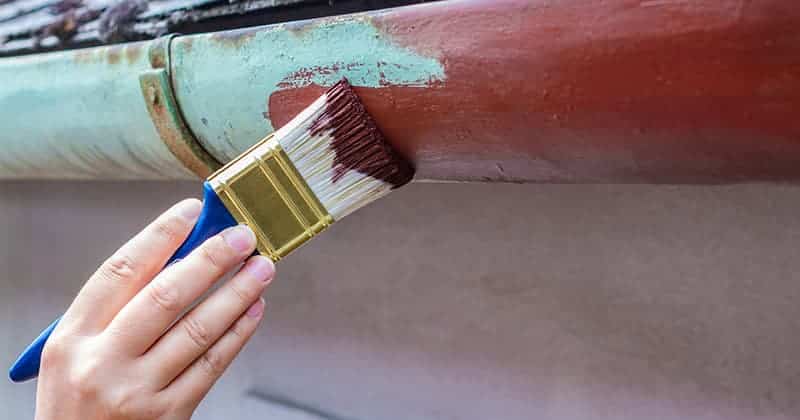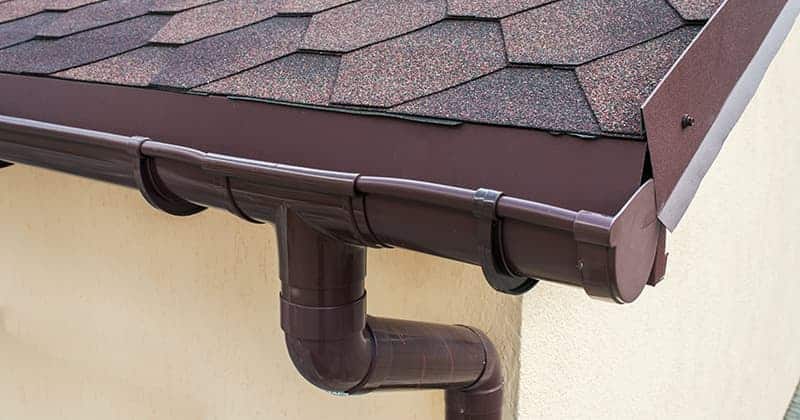Gutters are an essential part of every roofing system. They prevent water damage and flooding. They also sit in a very visible place at the edge of the roof. You might wonder if you can paint gutters to improve their appearance.
Gutters are typically aluminum or polyvinyl chloride (PVC). You can paint these materials, but you need to consider the type of paint and process to get the desired result.
On average, aluminum gutters last 25 years, and PVC models last 10 to 15. Painting can give older gutters a fresh look without replacing them.
Roofers can offer this option to their customers. They can learn the steps to paint gutters in case a customer asks, “Can you paint gutters?”
In this article, we will look at the reasons for painting gutters. We’ll discuss the techniques and different processes for painting. Then, we’ll end with a look at maintenance practices and tips for roofers who want to offer this service.
RELATED ARTICLE: How Long Do Metal Roofs Last? Everything Roofers Need to Know
Why Consider Painting Gutters?
Some homeowners may want to boost curb appeal by painting their gutters. This reason is certainly valid. But, as a roofer, you can highlight other benefits of giving gutters a fresh coat.
Here are four reasons property owners should paint their gutters:
- Enhanced protection: Newly painted gutters are not just about looks. The paint provides a key layer of protection. If you use quality paint, it can stop rust and corrosion that lead to leaks. The resulting water damage could ruin the roof or fascia.
- A cost-effective option: Gutters are cheaper to maintain than to replace. Rust removal and a fresh coat of paint can provide value. You can offer this service to customers who don’t want to invest in a full gutter replacement.
- Increased lifespan: Exposure to harsh weather elements can take a toll on gutters. Paint can serve as a shield. It protects gutters from UV rays, rain, and debris. A fresh coat every few years can reduce the chances of damage.
- More curb appeal: Let’s not forget the aesthetic factor. Faded or peeling gutters can detract from a building’s overall appearance. A new coat of paint in a color that matches the siding and trim can instantly improve curb appeal.
You can highlight the value of protecting gutters and enhancing curb appeal. Also, painting can be a worthwhile option for customers on a budget.
You might encounter skeptical customers when offering gutter painting. They may cite certain myths. Here are three of the most common misconceptions and why they are untrue:
- Myth 1: Metal gutters can’t be painted. Actually, most metal gutters, like aluminum, can be painted. You just need the right primer and paint for the surface.
- Myth 2: Painting gutters is hard. Proper prep and equipment are keys to straightforward painting jobs. Roofers have the right ladders and painting equipment for the job.
- Myth 3: Painting gutters is expensive. Compared to the cost of replacing damaged gutters, painting is a budget-friendly option. Supplies and labor cost much less than new gutter installation.
It’s important to understand the truth about gutter painting. You should also be prepared to answer questions about these myths.
FROM ONE OF OUR PARTNERS: What Questions Should You Ask a Gutter Installation Company?

Gutter Painting Techniques
Painting techniques are important. But the job starts well before you pick up a brush. Here are important steps for planning, prepping, and painting gutters:
- Choosing paint variety: The type of paint you choose depends on the gutter material. Acrylic latex is best for aluminum gutters. Vinyl gutters can be painted with exterior acrylic latex paint, too. But check the paint label to make sure it adheres to vinyl.
- Finding the right color: The right color can help improve curb appeal. Some customers may have strong opinions about color. Others may ask for advice. Select a color that matches the siding or window frames. Neutral colors like white won’t clash with most siding hues.
- Selecting the right application methods: Spray-painting gutters can be efficient. But it requires the proper equipment. Hand-held sprayers are best, as they are portable and lightweight. They won’t affect the balance on the ladder as much.
After selecting your paint and tools, it’s time to complete the project. Taking a step-by-step approach will ensure a high-quality result.
- Cleaning: Clean the gutters to remove dirt, debris, and loose paint. Choose a non-abrasive cleaning agent and water to remove grime. Ensure the gutter is completely dry before continuing.
- Choosing primer: This step involves choosing exterior-grade primers. You need a product designed for the gutter material (aluminum or vinyl). Primer improves paint adhesion and durability. Some primers help seal rust and prevent stains from bleeding through the top coat.
- Watching the weather: Avoid painting gutters in extreme temperatures. Also, consider the level of humidity. Ideally, pick a day with mild temperatures and clear skies. These are the best conditions for drying. Primers can take up to 48 hours to fully cure to form an effective undercoat. So, make sure you have a long enough window of dry weather to accommodate that.
- Painting: You can apply the first coat of paint after the primer is dry. If you are doing multiple coats, wait 4 hours or more between them for drying.
A systematic approach will ensure you don’t miss any necessary steps. These technical details will ensure a high-quality result sure to please your clients.
FROM ONE OF OUR PARTNERS: How to Grow a Service-Based Business
The Gutter Painting Process: Step by Step
You’ll want to effectively paint gutters and offer professional results. Customers need to see a clean, blemish-free finish. Otherwise, they might think they could have done the job themselves.
Here are 7 vital steps to pro-level painting results:
- Clean first. Use a stiff brush and non-abrasive cleaner to remove dirt. A clean surface is necessary for proper paint adhesion.
- Mask other surfaces. Make sure you cover surfaces you want to keep clean and paint-free. If you’re using rollers or brushes, you want to cover areas that might catch drips and spatter. If you choose to spray, your masking must be more extensive to protect against overspray, especially since even a slight breeze can carry it further.
- Address damage. Sand rust spots with fine sandpaper. You can use rust-removing chemicals for larger spots. You can also sand the entire gutter to remove imperfections. But you need to rinse and dry after sanding. This will remove any leftover grit and dust.
- Prime surfaces. Apply a coat of exterior-grade primer. The primer should be specifically for the gutter material. PVC and aluminum require different primers. Make sure your customer is aware of dry-times for the primer. You don’t want to rush into applying color. It could affect its durability.
- Paint top coat. Apply your chosen paint in thin, even coats. The first coat should dry completely before you begin the second. Look for missed spots after the first coat dries. If you use a spray tool, get corners or gaps with a brush.
- Clean again. Drips could get on siding or windows despite your best efforts. Use a damp cloth and mineral spirits to remove paint splatter.
- Allow to cure. The paint must cure fully. Follow the manufacturer’s instructions. The job isn’t complete until the paint is cured. Don’t attach downspouts or gutter guards until the curing period ends.
Customers will expect a professional result when investing in gutter painting. These steps can ensure a high-quality final product.
RELATED ARTICLE: Roofing 101: Pitch Finding

Maintaining Painted Gutters
Maintaining gutters can increase their longevity. Tell your customers that minor repairs and painting are cost-effective. These fixes are less expensive than a complete gutter replacement. Offering maintenance packages is another potential revenue stream for professional roofers.
What types of maintenance should you focus on? Here are 5 options:
- Regular gutter inspections: Inspect gutters once or twice a year. The best times are in spring and/or the fall. This helps find small issues, like chipping paint or small leaks. You can find them before they become big problems.
- Cleaning: Regularly remove leaves, twigs, and debris from the gutters. This is a chore many people neglect. Professional help may be appreciated.
- Touch-ups: It’s important to address small chips or peeling paint promptly. You can scrape and sand these imperfections. Then, paint over them to maintain a fully sealed system.
- Caulk: Use waterproof caulk on cracks or gaps around the gutter seams. This prevents water leaks. In cold climates, freezing can widen these gaps. Sealing cracks after inspections can help avoid this problem.
- Trim trees: Trim any tree branches that overhang the gutters. This prevents leaves and debris from accumulating and causing clogs. It can also reduce damage from branch strikes. These can cause dents and prematurely chip paint.
FROM ONE OF OUR PARTNERS: How to Estimate a Paint Job in 7 Easy Steps
Top Takeaway Tips for Painting Gutters
Gutters can be repainted every 3 to 5 years. You can pitch this service to your roof or gutter customers. Highlight the value of these services. Compare them to the cost of full gutter replacement.
You likely have the necessary equipment, like ladders. Plus, your team knows the proper safety procedures for gutter work. You only need to invest in painting tools.
Here are some steps you can take right now to start offering gutter painting to your clients:
- Communicate with current customers. Ask them if they’d like gutter painting services. Be sure to explain the advantages of regular painting for value and longevity.
- Incorporate measurement technology. No matter the size of the job, accurate measurements ensure you have enough primer and paint to complete it. RoofSnap gutter measurement tools offer a free trial and one free measuring report so that you can see how remote measuring can help your business.
- Calculate your costs. Find paint suppliers and inquire about pricing for paints and primers. Also, look for paint applicators. This information will help you understand the upfront costs of starting a painting service.
- See what your competitors offer. Do other roofing or gutter installation companies offer painting services? If they do, check their pricing. If they do not, market the service throughout the area.
- Brainstorm service packages and promotions. Package painting services with other gutter maintenance. For instance, offer painting and caulking. Or, provide painting at a discount for customers who get regular gutter inspections.


